Answers: June 2, 2022
Here are this week’s answers:
Question 1
CUT CRAPE MYRTLES TO GROUND?
Question: Five out of 10 Natchez crape myrtles planted 15 years ago are struggling this year but do show signs of life. I’ve read your comments and solutions on taking them down to the ground. Is it reasonable to give them another growing season? Valerie G., Rockwall.
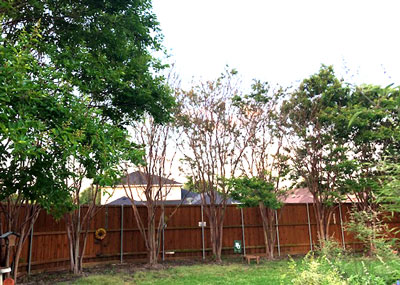
Answer: Natchez is one of the five varieties that have continued to die back to the ground in cold winters in our 23-year plantings in McKinney. Letting your plants go another year will not do anything to help them. If they are sending up strong shoots from the ground you need to capitalize on that vigorous growth and let it develop. That would mean taking the weak and dead growth out, probably cutting the entire plants back to within a couple of inches of the soil line as soon as possible. I know that’s going to play bad games with your design, and that’s not fun. For what it’s worth, they are planted too close together. If it were possible to remove every other plant, it would be better for the vigor of the remaining plants.
Return to list of this week’s questions.
Question 2
USE STUMP KILLER NEAR TREE?
Question: I have a magnolia tree that had six boxwoods surrounding its trunk. We removed the boxwoods but found it difficult to get rid of the boxwood roots without disturbing the magnolia’s roots. Would my magnolia tree be injured if I used stump killer on the shrubs’ roots? Bobby E., Richardson.
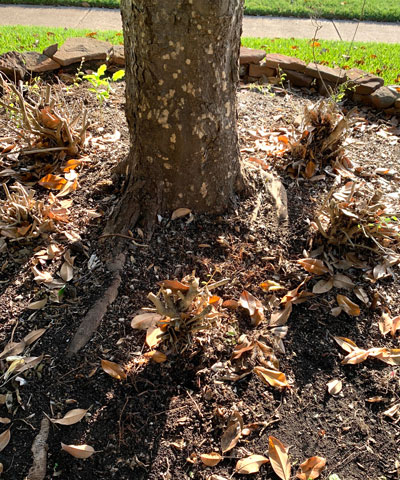
Answer: I really can’t imagine that you would need to use stump killer on boxwood roots. It is not worth the gamble. Soak the soil around each one of them individually and either use a sharpshooter spade or a pick to remove the stump. It won’t take as long as you might expect. Or, if you have a long-handled ax, a couple of sharp strikes could serve the same purpose.
Return to list of this week’s questions.
Question 3
WHY IS BUR OAK YELLOW?
Question: I planted a bur oak several years ago. Its leaves are yellow with dark green veins. They are turning brown and dropping. What could be wrong? Ginger L., Fort Worth.
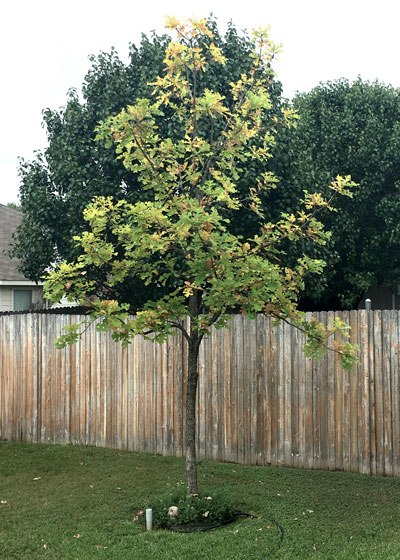
Answer: I have never seen a bur oak with iron deficiency, but that is certainly what this looks like. With other plants, extremely alkaline soils cause iron to be insoluble. However, bur oak normally does not need excessive amounts of iron. This looks more like a tree that has some kind of trunk or root problem. I suspect that it has an issue with root flare. It may have been planted too deeply. (See related story this issue.) You could certainly try an application of an iron additive, but concurrently you probably should pull the soil back away from the trunk to see where the roots are. Leave the root flare exposed out a few feet if you find that it’s too deep. You may want to have a certified arborist do that work with an air spade if you find that it’s more than a couple of inches too deep. (I can’t tell from the photo how likely this is, or whether there might be poor drainage or trunk damage of some sort.)
Return to list of this week’s questions.
Question 4
WHY ARE CAMELLIA LEAVES BROWNING?
Question: Our camellia took a hit in the winter cold. It was starting to look better this spring, but the new leaves have now developed brown ends. What is the cause and solution? The plant is west-facing and gets direct sun for about 4 hours. Karen D., Denton.
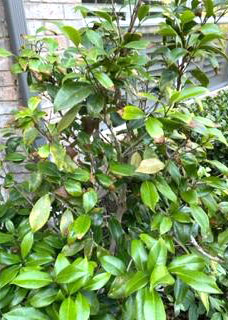
Answer: Anytime you have a plant with browned leaf tips or edges there is moisture stress going on. It can be from trunk or root damage, excessive fertilizer or other chemical injury, insect damage, leftover freeze injury, excessive direct sun or hot and drying winds. I can’t tell you just from a photo which of those might be the cause, but the DFW Metroplex is pretty far west of camellias’ preferred planting area.
Return to list of this week’s questions.
Question 5
WHAT HAPPENED TO MY CANNAS?
Question: I’ve been growing cannas for several years. This unusual pattern of holes has been getting worse. What can I do to stop it? John M., Lewisville.
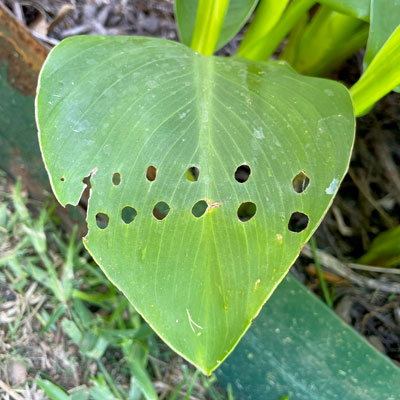
Answer: This is the damage of canna leafrollers. The larvae encase themselves within the rolled-up leaves. One leafroller worm chews a hole in its leaf and then, as the leaf unfurls, it looks like a machine gun has passed across it. Your best means of controlling them would be to apply a liquid systemic insecticide as a soil drench in early to mid-spring. That would mean when the plants are 8-12 inches tall, early April in South Texas and late April into early May in the rest of the state.
Return to list of this week’s questions.
Question 6
HOW CAN I KILL WEED GRASS IN ST. AUGUSTINE?
Question: What can we safely use to remove Johnsongrass in St. Augustine? It is tall and spindly. It becomes ugly within two days after mowing. Janice W., Olney.
Answer: Regular mowing will eliminate Johnsongrass in St. Augustine. The weed cannot withstand close mowing. Be sure that you are identifying Johnsongrass correctly, however. It is light green and will grow to 18 to 42 inches tall. In my experience, many people misidentify dallisgrass as Johnsongrass. Dallisgrass forms low, dense and dark green clumps. It sends up seedheads soon after mowing as you described. They bear hundreds of disk-shaped seeds, each bearing black, peppery specks. You would need to spot-treat the dallisgrass clumps with a glyphosate-only herbicide applied carefully to each clump. All weedkillers will kill St. Augustine, hence the need for spot-treating.
Return to list of this week’s questions.
Question 7
SHOULD FLOWERS BE REMOVED FROM HOSTAS?
Question: Should I remove flower stems from hostas like I do from my caladiums? Melinda A., Frisco.
Answer: No. Many people grow hostas for their flower stalks. They do not shut down the growth of additional hosta leaves like caladiums do to their plants. You might as well enjoy them, then remove them as soon as they are finished flowering.
Return to list of this week’s questions.
Question 8
WHY ARE TREE’S TIP LEAVES BROWN?
Question: What might cause dead leaves all over my ornamental plum tree? Most of the leaves are green, but there are patches of dead leaves. We have lived here 10 years and the tree was here then. Sally A., Granbury.

Answer: I have zoomed in on your photo and I believe you have an ornamental pear, not a plum. It looks like fire blight. That is a bacterial disease that attacks pears, apples and other members of the Rose Family while they are in full bloom. Infected twigs will die back a few inches. The control would be to trim off all of the dead twigs, cutting back a couple of inches into healthy wood. You would want to disinfect your pruning tool between each cut by dipping it into a 10-percent solution of chlorine bleach. When you are finished rinse and oil the pruning shears. Next year spray with agricultural streptomycin while the tree is in full bloom to lessen the spread of the disease.
Return to list of this week’s questions.
Question 9
WHY WERE COLUMBINES TINY?
Question: I had many, many flowers on my Hinckley’s columbines this year, but they were smaller than usual. Would that be a response to two cold winters, or is there a bigger problem? Janelle O., Bryan.

Answer: That’s normal for nature. When we have a peach tree with double the normal number of fruit we can expect them to be half the normal size. That’s why we thin the fruit. We also pinch flower buds off chrysanthemum stalks to grow larger “football” mums. Next spring I would suggest applying a high-nitrogen fertilizer in early March as the plants gear up to grow and flower. Keep them moist as well. This Spring’s drought had to figure into it as well.
Return to list of this week’s questions.
Question 10
WHAT CAUSED ZOYSIA LAWNS TO TURN BROWN?
Question: We have several spots in our zoysia lawn. Our neighbors have the same situation in their lawns. They are not near one another. What is this? Bill F., Tyler.
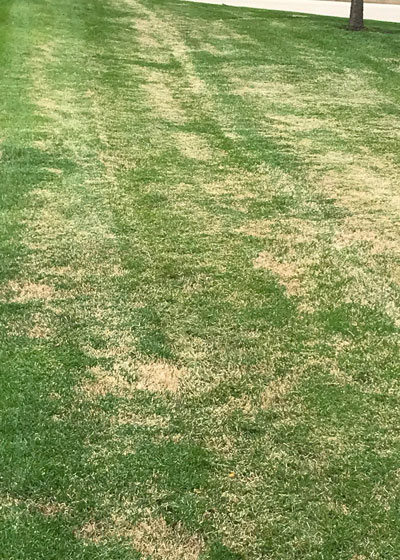
Answer: I suspect this is large patch fungus. This write-up from Oklahoma State University describes what your photo shows very clearly. Note that large patch used to be called brown patch. More and more universities are now changing how they refer to it and I guess I’m going to have to swing on over, too. The fungicide Azoxystrobin should work well to control it. It’s available at the consumer level as Scotts Disease-EX.
Return to list of this week’s questions.
Question 11
CAN I GROW LILACS IN TEXAS?
Question: I’ve always wanted to grow lilacs in Texas, but I thought they wouldn’t grow well here. I went to one of the big box stores last week and they had two varieties for sale. What is your opinion? Lucinda H., North Richland Hills.
Answer: I think you ought to be shopping at an independent retail garden center where you can talk to a Texas Certified Nursery Professional. (I do apologize, but I really want to support local nurseries with my every breath because they know local plants and conditions best.) I’m a Native Texan, but both of my degrees are from Ohio State. Lilacs grow beautifully in colder climates. You will see them growing along and slightly south of the Red River, but they are sad comparisons to what they are in the North. They do not like our warm winters and really hot summers. You will not be thrilled. Grow Catawba or other orchid-colored crape myrtles instead. Granted they don’t have the fragrance of lilacs, but they’re thrilled to grow here when lilacs are not. Here is the answer I leave archived in the 1001 FAQ section of my website.
Return to list of this week’s questions.
Question 12
HOW SHOULD A PISTACHIO BE WATERED?
Question: How should I water a large, new Chinese pistachio tree? It looked like this the day after it was planted. Marietta L., Tarrant Co.
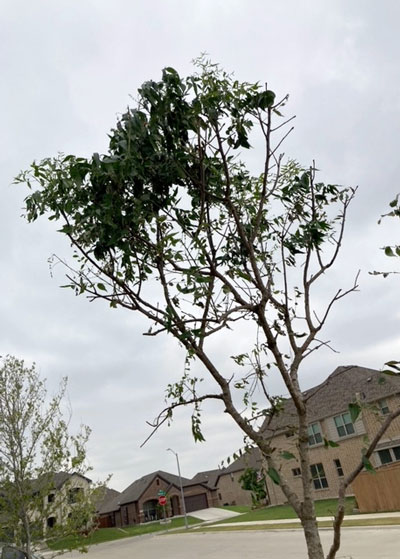
Answer: Soak it deeply every three or four days. Wrap the trunk to prevent sunscald for the next couple of years. I use paper tree wrap, but there are also plastic trunk-wrapping products you could use. Is this tree plumb? It looks rather awkward.
Return to list of this week’s questions.
Question 13
WHERE CAN I BUY GOOD WILDFLOWER SEEDS?
Question: I am planning a wildflower/pollinator garden and succulent area. Where could I find reliable wildflower and perennial seeds? Melody P., Parker.
Answer: The Texas wildflower specialists for the past quarter-century (probably longer) have been Wildseed Farms in Fredericksburg. https://www.wildseedfarms.com They have done so much to advance wildflowers across Texas. You’re in the Dallas side of the Metroplex. There are ample sources of great perennials in independent retail garden centers in the Dallas area. As for a succulent garden, as one who has loved and collected succulents since I was probably 10 or 11 years old, I’m going to suggest you grow them primarily in pots. I live within 20 miles of you. Our heavy clay soils and especially our area’s tendency every once in a while to have 40 inches of rain make growing succulents outdoors pretty risky. Add in the winter cold and your choices are very limited unless you can bring your plants into protection.
Return to list of this week’s questions.
Question 14
WHAT IS THIS BUR AND HOW CAN I CONTROL IT?
Question: After a recent rain I noticed these burs in my bermudagrass lawn. There are a good many large patches. What can I do to get rid of them? Mike A., Keller.
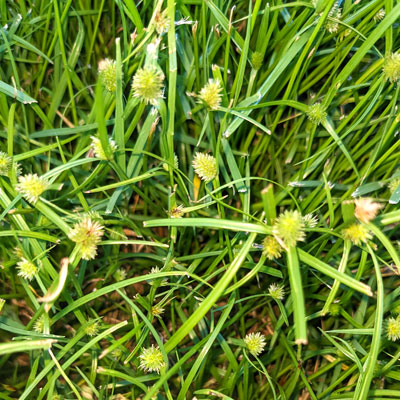
Answer: You have the nutsedge relative known as green kyllinga. It’s one of the more difficult members of the clan to eliminate. Here is a very good write-up on all of them along with controls from our friends at Texas A&M. Follow these guidelines closely and you can stop it. It’s probably been out there longer than you realize.
Return to list of this week’s questions.
Question 15
WHAT BUG ATE NELLIE R. STEVENS HOLLY?
Question: I thought Nellie R. Stevens hollies didn’t have any real insect problems. I was surprised to see leaf and limb damage. Please let me know how to treat these. Brent F., McKinney.
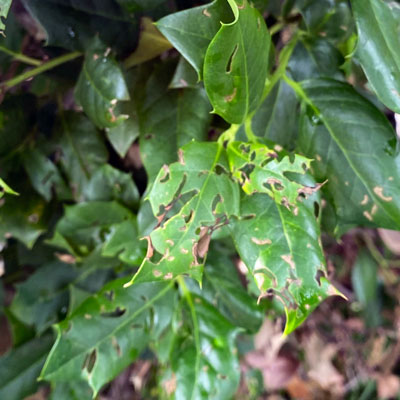
Answer: This is damage done by leafminers. I know it doesn’t look like it from your photo, but in the whole scheme of things, this isn’t a serious threat to the long-term well-being of the plants. You can see the trails the miners make in the leaves initially as they tunnel through. Then the tissue dies and falls away. I would apply the systemic insecticide Imidacloprid as a soil drench around the plants. Obviously, it won’t correct the problems with these leaves but it should protect the new growth. Next spring apply the systemic insecticide immediately after the plants finish flowering (after bee activity).
Return to list of this week’s questions.
Question 16
WHAT COULD HAVE HAPPENED TO MY TWO LEMON TREES?
Question: I have two lemon trees, one Meyer and one Arctic. Both were planted two years ago when they were about 3 feet tall. The first year I had three lemons. This year both were covered in flowers, but now both have dropped almost all of their leaves. There are no fruit in sight. They get morning sun, shade in the heat of day and then evening sun. What is wrong? Candy P., San Antonio.
Answer: The most likely cause would be that they got too dry one or more times. If they were outside, I guess it’s also possible that the cold damaged them this past winter. I’m assuming they were not planted in February 2021. That would have killed them entirely.
Return to list of this week’s questions.
